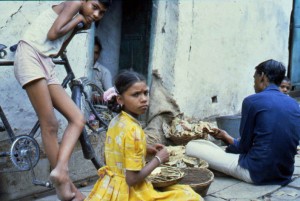Jim Yardley has an excellent story in the New York Times on Dharavi, a large Bombay slum. It is not clear exactly how many people live in Dharavi—probably no one is quite sure—but it is reported that there are estimated to be 60,000 dwellings, but since a slum household can be anything from 2 to 20 persons, that is not much help. What is sure is that the slum, while lacking basic infrastructure is a hive of activity. One resident entrepreneur estimates Dharavi’s annual economic output is between $600 million and $1 billion. When I was researching slums for a Canadian aid project, I remember an incident that put things into perspective for me. We were walking down a narrow dusty street when we glimpsed a group of young children sitting on the ground in a tight circle. What were they up to, I wondered? When we approached I realized that they weren’t playing but working—they were filling and sealing paper sugar packets. The red logo on the packets said “Air India.” Although slums, or informal settlements as the international aid community refers to them, are often described as part of an underground economy, that is inaccurate. Like cottage industries in Victorian England they are an integral—and important—part of the mainstream economy.


